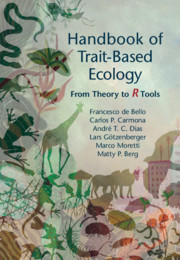Book contents
- Handbook of Trait-Based Ecology
- Handbook of Trait-Based Ecology
- Copyright page
- Epigraph
- Contents
- Preface
- 1 General Introduction
- 2 Trait Selection and Standardization
- 3 The Ecology of Differences
- 4 Response Traits and the Filtering Metaphor
- 5 Community Metrics
- 6 Intraspecific Trait Variability
- 7 Community Assembly Rules
- 8 Traits and Phylogenies
- 9 Effects of Traits on Ecosystem Processes and Services
- 10 Response and Effect Traits across Trophic Levels
- 11 Trait Sampling Strategies
- 12 Applied Trait-Based Ecology
- References
- Index
2 - Trait Selection and Standardization
Published online by Cambridge University Press: 08 March 2021
- Handbook of Trait-Based Ecology
- Handbook of Trait-Based Ecology
- Copyright page
- Epigraph
- Contents
- Preface
- 1 General Introduction
- 2 Trait Selection and Standardization
- 3 The Ecology of Differences
- 4 Response Traits and the Filtering Metaphor
- 5 Community Metrics
- 6 Intraspecific Trait Variability
- 7 Community Assembly Rules
- 8 Traits and Phylogenies
- 9 Effects of Traits on Ecosystem Processes and Services
- 10 Response and Effect Traits across Trophic Levels
- 11 Trait Sampling Strategies
- 12 Applied Trait-Based Ecology
- References
- Index
Summary
Chapter 2 provides general answers to some of the most frequently asked questions by researchers and practitioners aiming to apply trait-based methods: How to select the right trait(s) and how many traits should be selected? Where to find reliable trait values? Are the trait values provided in the literature or databases appropriate, and sufficient, for a given study system, or should traits be measured in the field? The need for standardization in trait measurements is discussed, particularly in terms of the importance of building reliable and useful trait databases. Different types of traits (quantitative, categorical, circular etc.) are introduced, as multiple types of traits are often needed to answer most ecological questions. A list is provided of existing trait databases from which trait information for different taxonomic groups can be obtained. The R material accompanying the book provides tools to extract trait data from some of these databases and combine it with other available species and community data.
Keywords
- Type
- Chapter
- Information
- Handbook of Trait-Based EcologyFrom Theory to R Tools, pp. 17 - 35Publisher: Cambridge University PressPrint publication year: 2021
- 1
- Cited by

